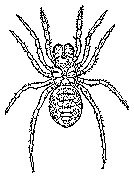Why do the spiders have come to make the webs?
Apr. 4, 2001. M.Sekine
The most primitive spider, so to speak a living fossil, is found on two
main islands in Japan, namely, Kyushu, and Okinawa, and its relatives are
also found in Southeast Asia. It is called kimura-gumo in Japanese,
belonging to the sub-order Liphistiomorphae.
As you know, spiders make silk, which is a type of protein, in special
glands within the abdomen. The protein is squeezed out through narrow tubes,
called spinnerets, and hardens as it emerges. The spinnerets are fingerlike
appendages, usually located at the tip of the abdomen. But the spinnerets
of the kimura-gumo are located in the middle of its abdomen, so the
spinnerets find it difficult to move adroitly and are not able to spin thread
well.
Probably, ancient spiders wrapped eggs with their thread. The eggs were
fastened to the surface with thread and remained safe. In this way, the
spiders' silk may have begun to be used from about three or four hundred
million years ago.
Then the spiders developed their skill in digging tunnels in the ground,
like kimura-gumo. After preparing burrows, the spiders lined their
shelters with silk. The earliest of all spiders would not have probably
been a web spinner; probably like other arachnids, namely, the scorpions,
harvestmen, and mites, because it was a spider, trailing a thread of silk,
or dragline, behind it. The draglines would not only form a silk lining
for the shelter, they would also radiate from it in all directions. These
diverging threads would acquire an unexpected value. Passing worms or primitive
insects would trip over them, causing them to pluck at the silk mat on which
the spider was at rest, and the slight movement underfoot would stimulate
it to rush out and have a hearty meal. The spiders were waylaying their
prey underground in the dense forests of the huge fern plants. In ancient
times when the spider appeared on the earth, the spider must have been a
superstar!
If spiders did not have silk, the number of species of spiders might
have probably been fewer, as that of the scorpion. And, if it were not for
their silk, various spiders would not have been able to inhabit diverse
environments. Spiders depend on silk throughout their lives.
However, insects became the champions of the land. The insects evolved,
had quick movement and had two pairs of wings. In the old days, the spiders
tried to capture insects, but the insects would have just flown into the
sky by their wings and escaped.
At that time spiders may have wondered about their future on Earth.
Spiders untangled this hard problem. The spiders came out from underground,
and started to weave their threads in the air, by changing the usage of
their dragline silk. In other words, the spiders built webs and entrapped
their prey in their webs. It was the most remarkable thing in the evolution
of spiders. The supreme accomplishment of spiders, perhaps, is the art of
spinning webs. The spider's web is among the great wonders of the natural
world. Spiders were finally able to manufacture several different kinds
of silk. The structural parts of the web, such as the bridge line, which
provides the vital top anchor, as well as the main supports and spokes,
are usually made of nonstick thread, while the fill-in mesh is made of a
sticky variety.
But many protein resources are need for spiders to make the webs in
the air. It is most important for spiders to catch insects that move quickly,
without using silk wastefully.
Therefore, spiders have come to seize insects directly with their forelegs.
Hunting spiders wait for or wander about in search of prey, running their
prey down (wolf spiders), or jumping on them (jumping spiders). They adapt
to various environments. As for the eyesight of jumping spiders, it progressed
very well. So they developed a new behavior pattern. Brightly colored and
ornamented with turfs of hair, hanging scales and curious spines, the jumping
spiders run about actively on the ground and on vegetation. While courting,
the little males dance and pose before the females, apparently to show off
their bright colors. It is thought that jumping spiders are the most highly
developed of all hunting spiders.
Unfortunately, there are limits to the new behavior pattern and modes
of life of the spiders. The spiders, without silk, find life impossible.


In the left-hand drawing, the kimura-gumo (Heptathela kimurai)
is seen from above. In the right-hand drawing, it is seen from the side.
Note that there are remains of the segmented body in its abdomen, and the
spinnerets are in the mid-ventral region of its abdomen.
Kumo or gumo is the generic name for "spider"
in Japanese, and kimura is the name that was dedicated to Dr. Kimura
Arika, who discovered it first in 1920.
The Illustrations are taken from Yoshikura, M. 1982. Kumo no fushigi
(The wonder of spiders). Iwanami-shoten, Tokyo.